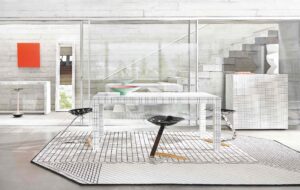 Heated Debate
Heated Debate
 We put Austin Williams, director of the Future Cities Project,
We put Austin Williams, director of the Future Cities Project,
and Sara Fox, building director for the Swiss Re building,
together in a lift to battle it out over sustainable architecture
and the implications of global warming.
By CONTACT _Con-3D0E05181 \c \s \l Michael Willoughby
Austin Williams: I think sustainability is one of the most low-aspirational, dangerous philosophies of our time. It has embedded the precautionary principle into design standards. It’s the notion of “let’s not build anything”. Or if we do build anything, we have to consider how it impacts on future generations.
You see that in architecture generally, where people are too busy going through risk assessments – benchmarking and box-ticking.
Sara Fox: OK. Sustainability is very difficult to define, but I think there are things one can do when designing an office building to use less energy and therefore create fewer carbon emissions. It’s basically two things; the way in which the products you use are manufactured, or how your building design addresses the energy issues. They both reduce the impact the building will have on the environment, and that is the sustainable design concept.
A: We’ve always tried to save on energy bills. The invention of fluorescent tubes
was seen as a general scientific advance – there wasn’t a song and dance about saving the planet. Now energy saving has become a general philosophical imperative about reducing impact on the planet. I don’t buy it. I think it’s a real problem to suggest we have to reduce consumption or rein in our material aspirations for the sake of having some kind of marginal impact on global warming or whatever the
hot topic happens to be.
S: OK, maybe we should take two steps back and you can tell me whether
you think global warming is a problem that’s caused by man.
A: Now you’re pulling the moral argument. Global warming – mention that and everything else goes out of the window. I don’t really mind whether it’s happening or not, because I believe in humans changing the world. Environmentalists subjugate this to the whims and demands of nature. We’ve gone back 300 years. Today, man’s seen to be the problem. Even architects are saying they want to “minimise their impact on the planet”. How sad! I think that everything we do is potentially progressive and liberating.
S: Well, let’s take a specific topic then – the use of rare wood. In Brazil, they are busy destroying the rainforest and so long as there’s a demand for that wood there will be an economic incentive for it to be harvested. Now, do you not think it is reasonable for a client or even an architect to try to select materials that are renewable, that can be grown on a plantation? Or to specify that it’s not being sourced from a place where the logging is causing deforestation or run-off issues and the rivers are being affected?
A: If you’re asking is it reasonable for an architect to specify that: yes. It’s reasonable for an architect to specify what he damn well pleases! I think we should have a bit more freedom of expression here. Allow people to make wrong decisions instead of right decisions. I’m in favour of development, not sustainable development. Sustainable development is a brake, and I think we should set an agenda whereby we have the ability and the freedom to make choices, and sometimes they’ll be bad choices.
S: So you’re fundamentally opposed to the design of an office being influenced by any issues to do with sustainability, is that correct?
A. No, I’m just fed up with it being everywhere! There’s another thing about sustainability, which is that it’s a triple whammy where one plays off against the other. You’ve got economic, social and environmental sustainability, and you can just pick one and ignore the others.
S: I agree in that I don’t believe that one should try to implement energy-reducing elements if the economics don’t make sense. For the Swiss Re building, it didn’t make sustainability sense to recycle the grey water, take it up to the roof and use it to flush the loos, because the energy you use in pumping it up to the top is far greater than the energy you save. So we didn’t do that. We could have covered the building with photovoltaic cells to take advantage of the solar energy, but we didn’t.
A: You could have not built it at all. And that’s the argument – the most sustainable architect is one who doesn’t build. That has no detrimental impact on the planet whatsoever. And this is the strange, defensive and stagnating discussion that architects are absolutely killing themselves over. You have to comply with all this regulatory gobbledegook, and if you can stick some aesthetic on the end of it you are doing very well.
S: So you think the new regulations that have come in are driven by this “moral high ground” search for answers to sustainability?
A: “Carbon, carbon, carbon” is the mantra of the age. That is what drives every regulation. If architecture has come to an exercise in working out carbon emissions, then we might as well all go home. So you have the carbon-driven regulatory nonsense, then comes the “worthy” aesthetic. Sustainability has
a look. Like [British eco-architect] Bill Dunster – a windmill on the roof, solar panel in the garden. It looks like it’s made of hay and it looks very worthy.
S: Grow some grass on the roof.
A: Exactly.
S: But the impact of these architects on the mainstream has been relatively limited. I think the real risk is that architects and designers put sustainability
as the primary objective, over and above the functionality of the building.
If you lose sight of the building’s original purpose, then what you’ve got is
a building that can’t be used for the purpose for which it was commissioned,
and that’s a huge waste of carbon emissions, because you have something
that should be torn down. And we can all point at buildings that have forgotten the purpose for which they were originally designed. Or never had one in the
first place.
A: The point is that whatever a building is, it has a role – and that it fulfils that role should be the first point of any brief. But I think that shows up the inadequacy of the sustainability argument – when you say that the turf roof and the alternative technology hasn’t had an impact.
S: I didn’t say that it hasn’t had an impact; I said the impact on the mainstream was limited.
A: I would agree with you, but I would actually say, bizarrely, that it has had
an impact. When you look at where those strange road protesters like Swampy from the early Nineties are now (they’ve all gone away and got jobs presumably), it must be quite a mainstream view. I agree with you that there aren’t masses of mud houses, but there are enough high-profile people like [British architect] Sarah Wigglesworth in this world who are building in bizarre materials. I just reviewed a book called Building with Sewage Sludge!
S: Architecture is subject to fashion, the same as everything. It’s probably arguable that, yes, sustainability is fashionable. It’s being enforced by legislation, but it is also fashionable. In the same way that organic shapes are fashionable – whether it’s round or curved or ovoid or blobby or whatever. Ten years ago there were a lot of buildings with pointy roofs. But I still maintain that it’s
possible to design a sustainable iconic building without letting it rule you in terms of aesthetics and economics. I would not promote buildings without air conditioning – think of the productivity of the staff this summer! – but I do think sustainability can inform your thinking without ruining it.
A: Yes, well, sadly, I don’t.
S: [Laughs] Well, we’ll have to agree to disagree.
A: Yes, we probably will, because nobody agrees with me. That’s the cross I
have to bear. Dangerous, farcical, reprehensible: I haven’t the words to express the contempt I feel for the precautionary principle. You don’t do something
today in case it might be detrimental?!
S: Is your contempt for it because you don’t think it’s going to work, or you
don’t think it’s worth preserving the future for the next generation?
A: You can’t preserve the future! With sustainability, you make a decision today that something you do may be detrimental tomorrow. Would we have invented the car if we’d had all the hype that it would cause childhood obesity and social fragmentation?
S: So, just get out there and do whatever you want?
A: I wouldn’t go that far. But if someone said that to me, I’d shake them by the hand. Look at the Thames Gateway. It’s half the size of London and it could be a new London. But Livingstone says you have to plug it into the existing Victorian infrastructure, because you can’t build a new reservoir because of CO2 emissions. So he encourages all London residents to bathe less. Use less water. Drink less!
S: I’m quite fond of showering on a daily basis, I have to admit.
A: I’m more of a bath person.




















